If you are entirely new to poker and aren’t sure of exact specific rules, or have never witnessed some weird preflop situations in poker, then this article will help you a lot.
Even if you played some poker before, then I am sure you can find something useful about reraising rules and strategy preflop. What you might not know is, that in a certain scenario you cannot reraise in no-limit Texas Holdem games.
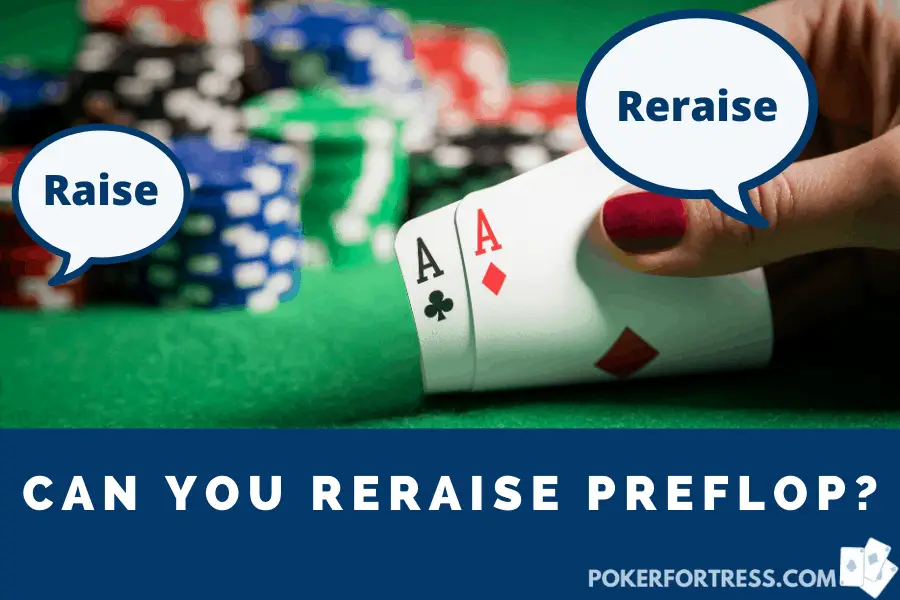
Can you reraise preflop? You can reraise in Texas Holdem no-limit games as long as you have more chips than the opponents bet. There are a few exceptions that rarely happen though. If a player has already gone all-in, and his allin bet is less than of a minimum raise, then you can only call and cannot reraise anymore preflop.
This is quite a common scenario where there are some short stacks on the table. Good players take this to their advantage.
Reraises, or often called 3bets, are often strong hands, but good players will know they need to mix it with some bluffs or widen their 3betting range in the right scenarios.
If you are only reraising QQ+ and AK, then you need to widen your range.
Why reraise preflop?
By reraising preflop we want to accomplish a few things:
- Get value for our premium hand
- Isolate a weak player by 3betting
- Reduce the number of opponents
- Chance to pick up dead money in the pot without the need to see the flop
Get value for our premium hand
When you have a premium hand, you want to get as many chips as possible from opponents. A great way to accomplish this is to make a reraise preflop. By 3betting, we ensure there will be more money in the pot on the flop already and gives us the chance to win 100bb or more from an opponent just by making normal-sized bets postflop.
Have a look at my 3bets graph. It includes all the 3bets, so not only the premium hands. You will make a lot of money by 3betting and playing a solid strategy. Such winrate is not possible in single raised pots because pots are smaller.
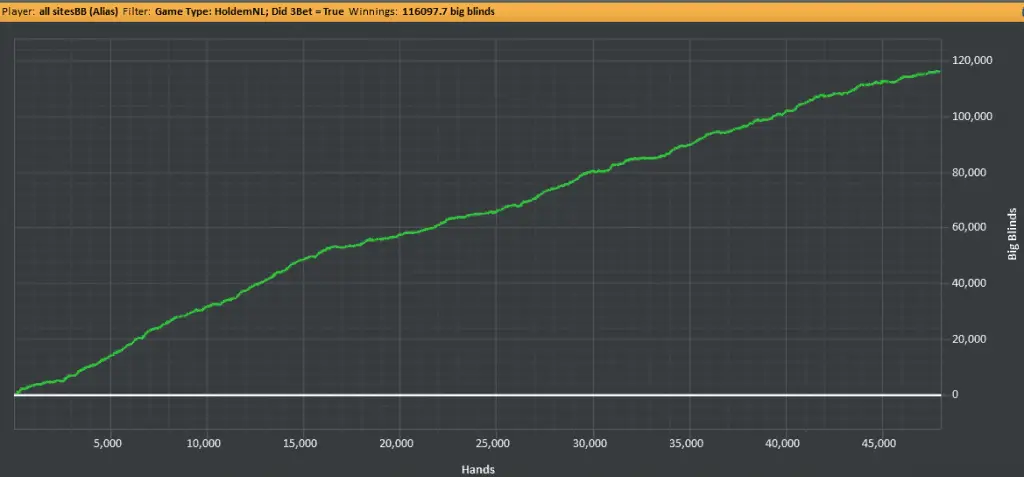
Isolate a weak player by 3betting
This is quite a popular move by poker regulars. Just note, this move will work more often in online games. In live games, players tend to fold less, even if there is a 3bet in front of them. So in live games, more often than not, you will not play heads up even if you reraise preflop.
Weak players are easily exploitable ones. Maybe they play fit or fold postflop, perhaps they call once and give up to further aggression. This is where stats become very useful, and poker pros rely very heavily on the use of a HUD in such scenarios.
Reduce the number of opponents
Equity and, therefore, the chance to win with your hand decreases for every extra player in the pot.
Check the example for AKs, that does well against a random hand. But when you are up against 3 opponents, you now merely have 41% to win.
| Our hand | Equity against 1 random hand | Against 2 random hands | 3 random hands |
| AKs | 67% | 50.75% | 41.44% |
For each extra player in the pot, our chance to win the hand with Ace-King suited goes down. When we reraise preflop, we usually make the pot heads up, sometimes it is 3 handed, and anything more than that is a rare sight in online games.
Chance to pick up dead money and pick up pot preflop
The only way to get your hand done preflop with is by folding and reraising. Because we think we can make money with our hand, we will of course, not be folding. Reraising gives us the chance to win a minimum of 4 or 5 big blinds for free, without the need to fight for it postflop. This is a great result! Also to mention pocket deuces are a slight favorite against AK. Wouldn’t it be great, if we could get 22 to fold, that raised preflop?
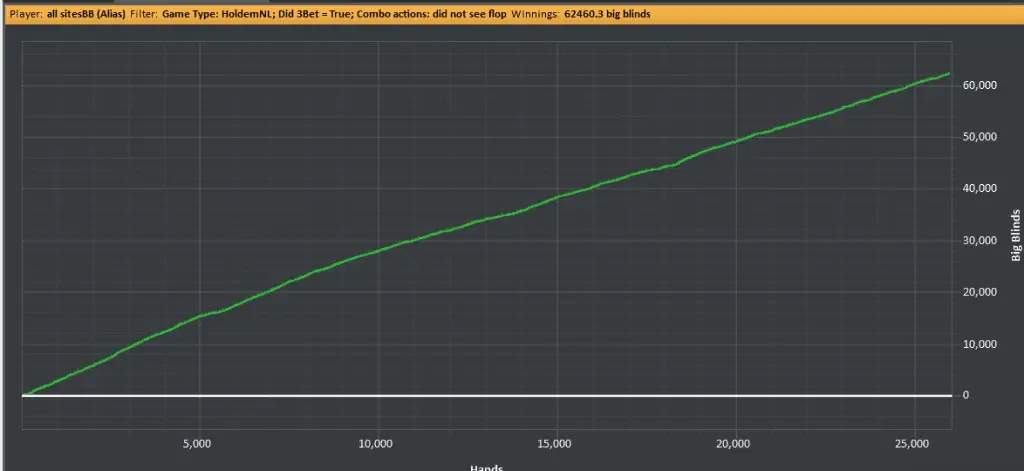
Look at this graph, now imagine you are playing NL100 games. How much money would that be? All made by players folding to my reraise.
Of course, people will fold to your pocket aces sometimes when you reraise, but so they will fold when you have a bluff. Most often, you will need to play postflop, as getting a fold doesn’t happen all the time.
For playing a winning post-flop strategy in 3bet pots, you need to get your fundamentals in place. Best is to follow some established rules, with which you will make consistent money. That’s how I learned to play. It didn’t come all-natural to me. I watched many hours of poker instructional videos and then applied what I learned on the tables. You get to see in videos what works and, most importantly, why.
The best thing of all is that you can do it also. And it is entirely free. The site just wants you to complete a simple quiz, and they will give you free $50 to play with on top of access to free videos. Don’t worry. They monetize in ways that don’t cost you any money, and only online poker sites are the ones that need to pay them money.
Which hands to reraise preflop with?
It is a good idea to have a solid preflop reraise strategy. And once you have notes and stats on opponents, you would either loosen or tighten your reraising range.
You can apply 2 different preflop reraise strategies.
Polarized reraise range
The first one is to have a value and a bluff range. This is often called a polarized range.
With such strategy, you could be 3betting AQs+ and AKo, JJ+, against early position open on 6max games. Then you add in the bluffs that aren’t your calling range.
- This strategy is useful against people that fold too often. Anything more than 50% fold is good to do polarized 3betting
- If you have a lot of hands that play better as calls than reraise. A good example is if you are on the big blind and button opens. You can make a profitable call with many hands as you get better pot odds to call on the big blind – you need to call 1bb less than in other positions, due to you posting a big blind.
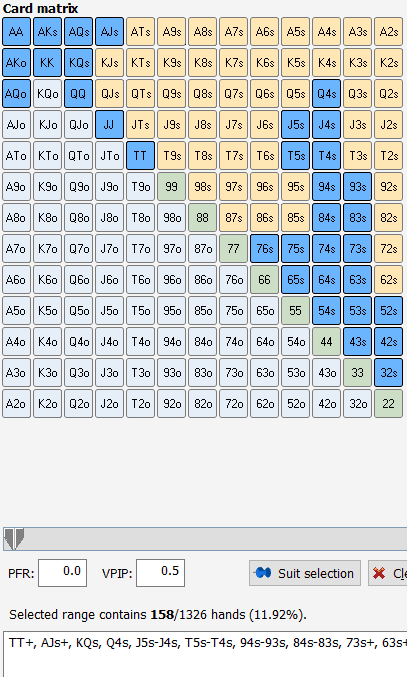
Merged reraising range.
This is premium hands and hands that have great playability. So no bluffs in here, just good hands.
- Very good if you are making a reraise out of position
- Good against tough opponents
- Great against calling stations
You should have a tightest reraising range when you are out of position in blinds and 3betting against an early position opener. The same goes for 3betting immediately after an early position open.
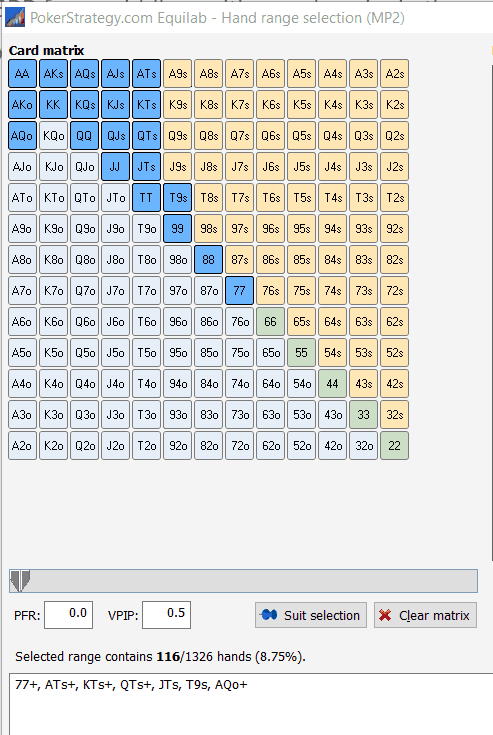
When to change your reraising strategy?
- If an opponent is tight, then reraise with better hands
- If the opponent is loose call machine, then 3bet merged range of hands
- If an opponent is very aggressive and likely to 4bet your preflop reraise, then firstly tighten your 3bet range, secondly have merged range of hands to reraise
- Stack size – don’t bluff 3bet shorties
- Opponent folds a lot to preflop reraise – bluff more often and consider calling some of your hands you would 3bet for value otherwise
How much should you raise in poker?
There is no set rule to how much do you have to raise in Texas Holdem. However, most usual sizings in online no-limit games are in the range of 3bb in earlier positions and get decreased on the button to either 2.5bb or to 2bb. In live games, a raise preflop will be usually higher as players tend to call more.
How much should you reraise to in poker?
Size of a reraise or what is called a 3bet preflop depends a lot on the table dynamics and the opponent you are up against. It also depends if you are in position or out of position.
It can vary from 7-8bb in position to 12 even 13bb out of position.
- If you are reraising with merged range, then make it close to 3x reraise in position, and 3.5x to 4x out of position.
- With the polarized range, you can reraise with a bit lower sizing. But don’t go lower than 2.2x (7-8bb against a 3bb open). Out of position, make it around 3x.
- If there are a raiser and a caller, then you need to adjust your reraise sizing accordingly. Increase it for each payer that called. So with 1 caller, make it close to 4x the initial raiser sizing in position and a bit bigger out of position, if you have merged range. Do the same with the polarized range.
Conclusion
I showed you that in the majority of the times you could reraise preflop. But on rare occasions, you cannot reraise preflop anymore because rules of minimum raise size weren’t met.
Now you also know 2 different styles to consider when going for a reraise preflop. Moreover, you know to use which. All of this is already a lot more than some micro stakes players know. Now it is on you to apply these strategies on tables and keep practicing.
It is nothing wrong if you only stick to one of them at first until you get comfortable with it.
If you keep struggling after a while, then I strongly advise you to either join a free poker strategy site that helped me become a winning poker player or hire a coach.



